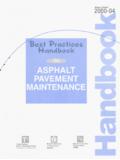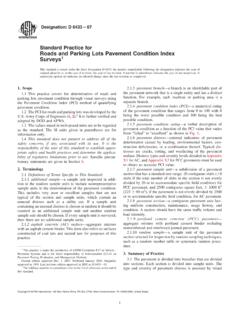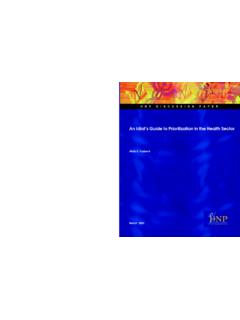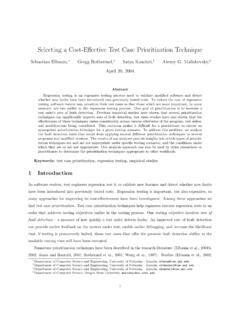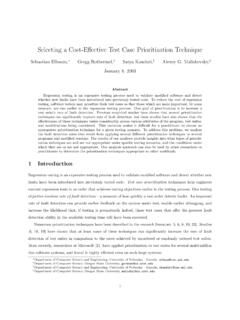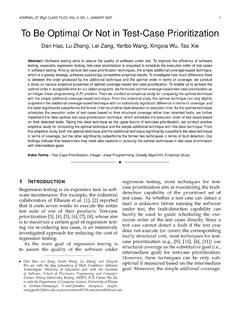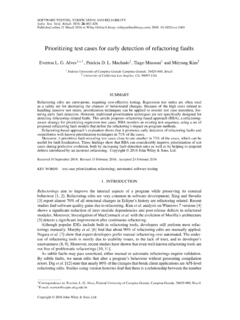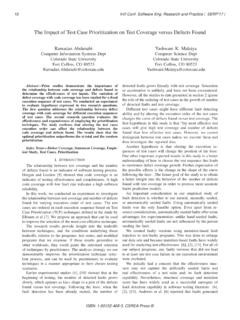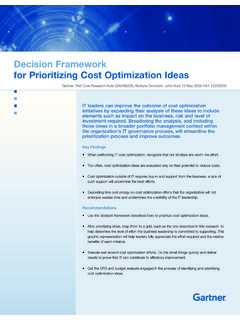Transcription of Prioritization and Programming - MTU
1 1 Prioritization and ProgrammingPrepared by Bernard D. Alkire, Technological UniversityTribal Technical Assistance ProgramJuly 1998 REVIEW DRAFT2 ContentsIntroduction .. 3 Goals .. 4 Objectives .. 6 Prioritizing 8 Evaluate Projects Using Goals .. 9 Evaluate Projects Using Objectives .. 11 Judgment Techniques .. 12 Numerical Analysis Techniques .. 13 Weighting .. 15 Ranking Techniques .. 16 Analytic Hierarchy Process (AHP).. 22 Other 28 Selection of Method.
2 31 Prioritization 33 Other Programming Considerations .. 43 Programming Summary .. 44 Related 453 IntroductionTransportation planning is the development of strategies for the design, con-struction, maintenance, and operation of facilities for moving people andgoods. The transportation planning process is coordinated, continuing planning can include such activities as classification of traffic safety studies analyzing transportation needs financial planning, coordination with state, federal, tribal,and other levels of typical transportation plan will identify projects that need to be completed inorder to satisfy the plan.
3 What the plan does not usually contain is any kind ofprioritization of the identified projects. This task should be the job of the triballeadership, because they control the manual discusses Prioritization and Programming of projects, importantsteps of the planning process that are often not given proper attention. Sev-eral techniques for developing the project selection and Prioritization list will bepresented. They range from simple to complex. Users will likely use themethod that is most appropriate for their also needs to be considered by tribal leaders.
4 Programmingmeans staging the prioritized projects over time, based on available may be short-term or long-term. What is considered in thismanual relates to the short term (1-5 years).Priorities are based on the goals and objectives of the tribe. Therefore, beforewe can begin to prioritize, we must identify the tribe s goals and goal is an ideal, and as such is expressed in abstract terms. It is in everysense intended to be a community consensus, a base on which alternativescan be goals need to be identified for each transportation problem.
5 Somegoals may be available from an overall tribal, regional, or state developmentplan. Other broad goals can be identified from general tribal policy statementsand through the political leadership. In many cases, goals are arrived at inreaction to a crisis that was unforeseen or the process of goal determination, there must be ample opportunity forparticipation by the public at-large and particularly by interested groups withinthe tribe. Setting the transportation goals in context with the goals of the tribewill exhibit the awareness of the relationship between transportation and theother things the tribal membership wants and needs.
6 The goals of the tribemust be the guide in prioritizing the transportation cannot be attained once-and-for-all. They must be continually soughtanew. Goals may become unattractive with the passage of time. Thus, whatis acceptable today may be unacceptable tomorrow. Goals must be in continu-ous development to reflect the developing needs and wishes of the tribal are acceptable goals and what areas do they cover? Based on theabove discussion there is no one-size-fits-all solution to this question. Toillustrate some possibilities of goals within a series of broad subject areas, thefollowing are provided as typical goals.
7 Which may or may not relate directly orindirectly to GoalsSocialMore equitable distribution of incomeCompatible neighborhoods within the tribal communityInvolve tribal members in the decision-making processProvide a sense of communityProvide stability and security for tribal membersImprove living conditions for tribeEnvironmentalPromote clean air and a trash-free landscapeLower levels of noise pollutionReduce water pollutionFinancialPreserve the tax baseLower transportation costPromote economic growthTransportationImprove access to employmentProvide for access to tribal facilitiesPromote multiple modes of transportationIncrease safety of transportationImprove MobilityObviously this list is not comprehensive and each tribe should be able to de-fine other goals that meet their particular are the added refinements needed to analyze the goal.
8 An objec-tive is a result one intends to achieve. The objective provides the specificmeasurable statement that can be used to assess the goal in relation to thegiven objectives need to be identified for each transportation goal. In orderto assess the contribution toward the attainment of a goal, the objectivesshould be stated in a way that can be used as a measure of the project s con-tribution to achieving the objective statement should be structured to match the attitude of the com-munity. Care should be taken to ensure the stated objective is not used justbecause it is easy to measure.
9 Some important objectives may in fact nothave a easily measurable that each of the objectives listed in the chart is a statement that has ameasurable answer. For example, the objective to decrease travel time towork can be analyzed using standard delay-study methods known to trafficengineers. This data may require some effort to obtain but that does not pre-vent the tribal planner from obtaining the delineating goals and objectives, the decision-makers and their staffs muststrive to attain a balance between goals that are so broad as to be meaning-less, and objectives so specific that they hinder the Prioritization the goals and objectives of the tribal government have been stated anda transportation plan has developed a set of projects.
10 It is necessary to evalu-ate the projects in some way in order to select the best possible project interms of the goals and Goal Improve Living Conditions for TribeObjectivesIncreasing number of housing units availableto tribal membersReducing average cost of housingIncrease transportation in underserved areasEnvironmental Goal Reduce Water PollutionObjectivesReduce Biological Oxygen Demand instreamsPrevent salt intrusion from winter roadmaintenanceImplement well-testing programFinancial Goal - Promote Economic GrowthObjectivesIncrease access to jobsReduce cost of transportationReduce cost for land developmentTransportation Goal - Improve MobilityObjectivesDecrease travel time to workIncrease transit opportunitiesIncrease number of paved miles onreservationImprove park and ride facilitiesInstall traffic control devices atcritical intersectionsReduce number of vehicles/day8 Prioritizing MethodsPrioritization is a process for assisting in the determination or selection of thepreferred project from among a
